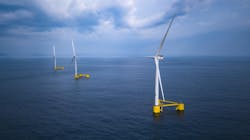DNV GL predicts strong growth for floating wind
Offshore staff
HOVIK, Norway – Floating wind will contribute 2% of the world’s power supply by 2050, according to a report by DNV GL.
However, more comprehensive industry standards and risk management are needed to scale up the technology in line with requirements.
The report also predicts that the cost of floating wind will come down by around 70% by 2050 to a global average of 40 EUR per MWh.
“We know that floating wind is technically feasible; the challenge now is to move rapidly to commercial deployments,” said Remi Eriksen group president and CEO of DNV GL.
“The know-how from bottom fixed offshore wind, the competences of shipyards, and of oil and gas contractors all broadly align with the technical, logistical, and operational challenges of floating wind.”
In its recent Energy Transition Outlook 2020, the consultancy forecast that the installed capacity of floating wind would grow from the present 100 MW to 250 GW in 2050, a 2,000-fold increase.
The technology is independent of ocean depth, and can therefore help bring wind power in particular to the large cities in the Asia/Pacific region.
Key to cost reductions will be larger turbines, larger wind farms, and the formation of a cost-competitive supply chain.
Magnus Ebbesen, Floating Wind lead at DNV GL said: “There is a lot of room for innovation and optimization, but also for brand new solutions. That brings some risk, but risks that can be managed and minimized.”
12/04/2020

